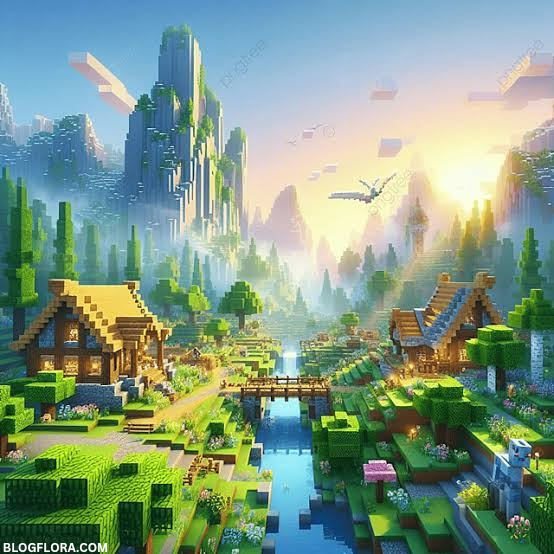Minecraft (2009) has caught the imaginations of millions of players since its introduction, providing a unique sandbox experience. While building and exploring are important aspects of the game, what distinguishes Minecraft is the opportunity to personalise your creations. Among the numerous customisation choices, game icons and banners have become indispensable tools for gamers seeking to show their creativity and personality.
In this post, we will look at the history and significance of Minecraft (2009) game icons banners, how they have changed over time, and how you may build and customise these components to improve your in-game experience.
Evolution of Minecraft Game Icons
When Minecraft (2009) was initially published, the game’s user interface (UI) and icons were rather simplistic. These icons represent in-game tools, blocks, objects, and features. The symbols have developed throughout time in tandem with the game’s upgrades and expansions.
Minecraft game symbols range from early pickaxes and swords to more recent additions like as enchanted books, shulker boxes, and netherite gear. They are intended to be both functional and visually accurate of their in-game equivalents. The clarity and uniformity of these symbols allow players to simply traverse the game’s extensive inventory system and comprehend the functioning of each item.
One of Minecraft’s symbols’ main merits is their pixel-art design, which pays respect to the game’s old images while being clear and simple to interpret. This uniformity in design makes Minecraft (2009) game icons readily recognisable to both experienced and new players.
The Role of Banners in Minecraft (2009)
Banners were added in Minecraft with the 1.8 update, and they have since been a popular way for people to personalise their settings and show their unique personalities. Banners are ornamental objects in Minecraft that may be used as flags, planted on the ground, or attached to walls. They may be coloured and printed in a variety of ways, opening almost unlimited creative possibilities.
The option to build personalised Minecraft banners has increased the game’s personalisation. Banners are commonly used by players to symbolise their factions on multiplayer servers, to adorn their bases, and to designate certain spots on maps. Banner-making allows players to be as creative as they want, utilising patterns, colours, and combinations to create distinctive flags and insignia.
Here are some popular usage for banners in Minecraft (2009):
- Decorative Purposes: Banners are used by players to give flair to their houses, castles, and strongholds.
- Faction Symbols: Banners are frequently used on multiplayer servers to symbolise organisations or factions, allowing players to demonstrate their allegiance.
- Map Markers: When you place a banner and then right-click it on a map, the banner’s position will display as a marker on the map, making it easier to explore big worlds.
How to Design and Customise Banners in Minecraft
Making Minecraft banners is a rather straightforward procedure. To make a banner, you’ll need six wool blocks of the same colour and a stick. Once you’ve created your banner, you can begin customising it using dyes and patterns. Here’s a simple guide on creating and customising banners in Minecraft (2009):
- Gather Materials: You’ll need wool, dye, and a work table. Using different colours of wool and dye, you may customise your banner with varied tones.
- Create a Banner: Place six wool blocks and one stick on the crafting table in the proper pattern to make a basic banner.
- Customise Using Patterns: In Minecraft, use the loom to create patterns for your banner. To make elaborate designs, utilise colours and pattern templates (such the creeper face or skull and crossbones).
anner designs may be combined in over 30 billion ways, making it one of the game’s most customisable elements.
The Significance of Game Icons and Banners in Minecraft Culture
Both game icons and banners in Minecraft (2009) play important parts in the game’s culture and community. The symbols, which represent various objects, tools, and blocks, are essential for the day-to-day gameplay experience, allowing players to manage their inventory more effectively. The easy design of these symbols enables gamers to easily identify what each item accomplishes, hence increasing the user experience.
Meanwhile, banners have become a form of expression in the Minecraft community. Banners have become an important component of how players interact with and personalise their in-game settings, with online guides on how to create complicated banner designs and people displaying their homemade flags on popular servers.
These aspects also link to the larger Minecraft modding community. Numerous Minecraft texture packs change the design of icons and banners, giving them a new style that is consistent with the altered content. For example, a medieval-themed texture pack may replace the normal sword symbol with a more ornate design, whilst a sci-fi pack may transform a banner into a futuristic flag.
Final Thoughts On Minecraft (2009) Game Icons and Banners
Minecraft (2009) remains popular as a game because to its emphasis on creativity and customisation, and the use of game icons and banners is an important element of that experience. While game icons give players the tools they need to effectively traverse their environment, banners provide limitless options for personalisation and creativity.
As Minecraft progresses, so will the ways in which people employ its features to create more immersive and unique worlds. Whether you’re making your first banner or using a texture pack to tweak your game icons, Minecraft allows you to personalise the experience in numerous ways.
Understanding and using Minecraft (2009) game icons and banners allows users to enhance their gaming experience and immerse themselves in the limitless possibilities that Minecraft provides.
Also Read: Abraham Quiros Villalba: A Rising Star in the World of Innovation and Technology

